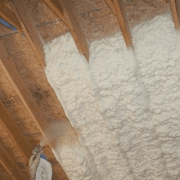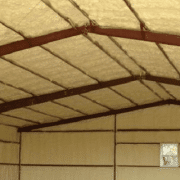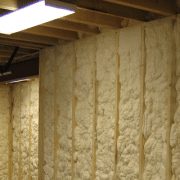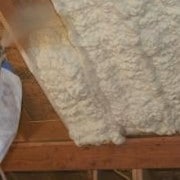How To Build Jon Risch’s DIY Acoustic Panels
[ad_1]
Jon Risch’s DIY acoustic panels have changed my system more than any other tweak and component upgrade. After placing the panels at my listening room’s early and diffraction reflection points (two behind the speakers and four on the sidewalls (the two panels closest to me actually sit in easy chairs because I can’t move the chairs out of the way)) I heard these improvements. Since that initial listening session I’ve had mixed results from CDs played in my Pioneer DV-47ai and Taddeo Digital Antidote II: certain frequencies and instruments are too laid back. I’ll remove the Taddeo and see if I get the same great performance as from my Airtunes playing MAX ripped Apple Lossless tracks.
Read on for my tips and tricks to build these panels yourself and save up to 90% over commercial acoustic panels.
Materials needed for 6 17×48 inch acoustic panels:
* Home Store: 24 feet R-25 Insulation (15 in. wide and 8 in. thick)
* Home Store: 16 4 foot long 1×4 Std boards
* Home Store: #8 2 in. Screws (I bought the self-drilling kind so I only had to drill countersunk pilot holes in the long boards of the frame, the shorter boards to the screws without any splits)
* Home Store: 9/16 Staples (you need the long staples to get through the many layers of fabric and batting)
* Fabric Store: 10 yards 4 oz. 100% Polyester Batting
* Fabric Store: 10 yards Burlap (let your spouse help pick the color, then she can’t complain later)
Tools needed:
* Power Drill/Driver
* Corner Vise (spend at least $8, the $3 one broke as soon as it touched wood, which cost me another trip to the home store)
* Staple Gun (you will be stapling like a madman on this project so be sure and get a nice staple gun, I killed my Black and Decker Powershot half way through the project and had to buy a new one that still had jamming problems, so don’t use a Powershot, get a nice Arrow gun)
* Miter Hand Saw
Construction
Wood Frames
* Match 4 ft. studs for length into 6 pairs
* Take 4 worst studs and cut down to 12x 15 in. lengths with hand miter saw (or table saw), make 90 degree cuts
* Take a small scrap of 1×4 and mark depth at either end of 4 ft struts
* Drill 2 counter sunk pilot holes at each end in the middle of the marked off area on the long boards
* Using a 90 degree corner vice, butt up a short and long post. Drill screws through the pilot holes into the short board. Repeat for the other long and short pair. You now have two “L” shapes.
* Attach the two “L”‘s just like in the previous step to form a rectangle 17 in. x 48 in. x 4 in. depth.
Attach Insulation to Frames
* With all the frames finished set up two saw horses (or storage boxes like I improvised) in an area where you can easily cut and clean up fiberglass (like your garage)
* Measure the inside length of your first frame, it should be about 46 in depending on the accuracy of your long 48 inch 1×4’s.
* Put on your fiberglass insulation protective gear (my get up includes a respirator, suede gloves and Tyvek coveralls (sweaty))
* Partially unroll your insulation on a cutting surface (like the concrete garage floor) and measure a length of 46 in. (or whatever the previous inside length of the frame was)
* Lay the frame across the saw horses with the horses about a quarter length in from each end
* With the kraft face side up, press the insulation into the frame. Staple the paper strips to the frame, securing the insulation.
* Set first frame aside and repeat for the rest.
Wrap frame in Polyester Batting
* Roll out your polyester batting on the same cutting surface as the insulation (you should have this all cleaned up now)
* Measure the length and add it to depth of either end of the frame including the insulation thickness. I decided to cut the lengths of my batting at 60 in. lengths (frame = 48 in. length + 2 x 6 in. depth) and keep the width to 48 in.
* Set the frame on the saw horses facing up (the kraft side of the insulation on the opposite side)
* Lay the polyester batting on top of the frame. Get the length as even as you can while positioning the batting along the width so the side closest to you hangs down about an inch below the frame, the opposite side should be hanging down by 24 in.
* Tuck the the short side batting between the bottom of the frame and the saw horses and flip the frame toward you so the 24 inch side falls across the kraft side of the frame.
* Staple along back frame
* Cut away excess batting and staple ends after folding like wrapping paper
* Make sure no insulation is exposed, the batting should completely encase the front, back, sides, top and bottom of entire framed fiberglass panel.
Wrap Frames in Burlap
* Wrapping the frames in burlap is just like the polyester batting with some tricks
* Cut the burlap to 60 in. lengths (another how to suggests starting a cut in the burlap and then pulling a loose string from the cut to create a straight line to cut along. This didn’t work for me, pulling the string would bunch up the fabric and then snap, at best I would get a straight line across half the cut)
* Lay the fabric over the panel unevenly and flip, wrapping the fabric around the back as described above with the polyester batting
* Pulling the burlap snug staple the long sides to the back of the wood frame
* Fold and staple the burlap to the bottom end of the frame like you’re wrapping a present
* Take off saw horses and give open top end a tug to pull front of fabric tight until wrinkles disappear. Cut away excess fabric and staple.
* Finish with fabric border to cover up staples
Place Frames at Early Reflection Points in your Listening Room
* While sitting in your sweet spot have a friend move a small mirror along your front and side walls. Have your friend mark the points along the walls that you can see the speaker drivers for the side walls and the inside corners of the loudspeakers on the front wall (or if you’re like me and couldn’t bring yourself to ask your eight month pregnant wife to slowly walk around with a mirror and tape you can use a CAD application or this formula and verify the calculated locations with a mirror taped to the wall in the approximate place)
* Place the panels at the mirror points (I’m just leaning mine against the wall at an angle so they don’t fall over, I’m not attaching the panels because I need to move them out of the room when not in use), bass absorption is improved by placing the panels at least four inches out from the wall
* Listen and enjoy!
[ad_2]







